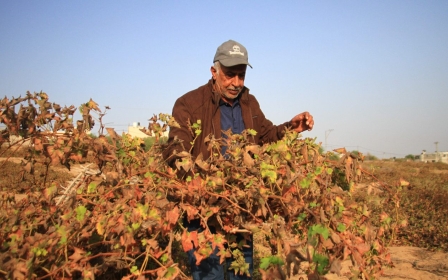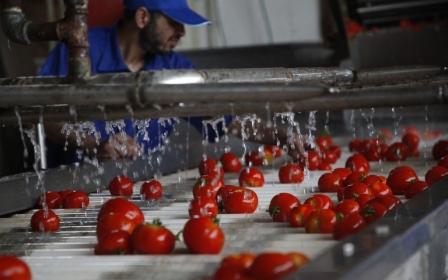Israel carries out aerial spraying of herbicides near Palestinian farmlands
For four days in a row, Israeli crop duster planes have been flying near the eastern Gaza Strip, spraying chemicals believed to be herbicides in close to Palestinian lands adjacent to the border fence.
'We have been going through the same scenario for years now, every couple of weeks they send drones to spray our lands to damage the crops'
- Youssef Abu Maghadid, Palestinian farmer
The frequency of the spray is determined by the direction of the wind, eyewitnesses say, adding that the spray stops when it rains, or when the wind blows “in the opposite direction”.
“They only start spraying along the border fence when the wind blows west, in the direction of the Palestinian lands, in order to allow the herbicides to cover a larger area inside our lands,” Palestinian farmer Youssef Abu Maghadid told Middle East Eye on Thursday.
“But when the wind starts blowing east, they immediately stop because it would harm them.”
In Gaza, around 40,000 Palestinians depend on farming as their only source of livelihood.
New MEE newsletter: Jerusalem Dispatch
Sign up to get the latest insights and analysis on Israel-Palestine, alongside Turkey Unpacked and other MEE newsletters
Maghadid estimates that the latest spraying was conducted over at least 60 hectares of farmland, directly affecting the livelihood of 35 to 40 farmers.
Farming made difficult
The Israeli army regularly claims that the herbicides are used to clear vegetation in the buffer zone on the Gaza side of the fence in order to have a clearer view of the area for military purposes.
But Palestinians say the policy inflicts wide-ranging damage on the residents of Gaza. Maghadid accused the Israeli authorities of intentionally damaging Palestinian crops in the eastern farmlands using various tactics over the years.
“We have been going through the same scenario for years now, every couple of weeks they send drones to spray our lands to damage the crops so that they can monitor the area more clearly.
“Sometimes this happens only a few days before the harvest season… You can imagine the amount of losses we endure,” said the 47-year-old farmer.
Aside from the spraying of herbicides, Palestinian farmers also have to deal with the constant firing of tear gas by Israeli forces deployed along the border fence in eastern Gaza.
“Just today alone, Israeli forces fired more than 10 tear gas canisters at shepherds to keep them away from the buffer zone, but the wind blows the gas towards us, and we have to leave our lands several times a day to avoid inhaling it. This happens on a daily basis and several times a day,” Maghadid said.
‘Herbicidal warfare on Gaza’
According to rights groups, Israel has been conducting aerial herbicide spraying in this area for several years, and the activity is typically carried out “without prior notification or warning to Palestinian farmers".
'This ongoing practice has not only destroyed entire swaths of arable land along the border fence, but also crops and farmlands hundreds of metres into Palestinian territory'
- Forensic Architecture
Israel carries out the spraying when the wind is blowing westward, which transports the chemicals “deep into Gaza”, reaching distances “as far as 1,200 metres into the Strip", activists say.
“Since 2014, the clearing and bulldozing of agricultural and residential lands by the Israel military close to the eastern border of Gaza has been complemented by the unannounced aerial spraying of crop-killing herbicides,” the research group Forensic Architecture found in 2019.
The London-based agency spent over a year examining the environmental and legal implications of the Israeli practice of aerial spraying of herbicides along the Gaza border.
“This ongoing practice has not only destroyed entire swaths of formerly arable land along the border fence, but also crops and farmlands hundreds of metres deep into Palestinian territory, resulting in the loss of livelihoods for Gazan farmers,” the agency said in a statement.
Recurring losses
Farmers would not see the full scope of damage caused by herbicides until days or weeks after the spraying activity, said Iyad Abughleba.
"We still cannot determine if the spraying has incurred any damage to the crops. It usually takes up to eight to 10 days until dark spots start appearing on the leaves, and this is when we know that they are damaged and cannot be harvested," the local farmer told MEE.
"We are supposed to harvest the crops, including peppers, courgette and wheat in the next two or three months. If the herbicides have indeed affected the crops, which we will know in around a week, then the whole season is ruined, and tens of thousands of dollars are lost,” Abughleba said.
As a result, many farmers are facing increasing debts due to Israel’s continuous practice aimed at damaging Palestinian crops, Abughleba said.
The situation worsened when Israel attacked Gaza in May 2021, leading to an estimated loss of $204m in Gaza’s agricultural sector, according to the Palestinian Ministry of Agriculture.
“We are still struggling with the consequences of the last attack on Gaza that causes us huge damage due to the shelling and levelling of lands, as well as abandoning the crops throughout the 11 days of the attack and then having to deal with Israel’s decision to close the borders and prevent exports,” Abughleba said.
“We are not ready for another year in which our agricultural lands are targeted continuously."
This article is available in French on Middle East Eye French edition.
Middle East Eye delivers independent and unrivalled coverage and analysis of the Middle East, North Africa and beyond. To learn more about republishing this content and the associated fees, please fill out this form. More about MEE can be found here.





